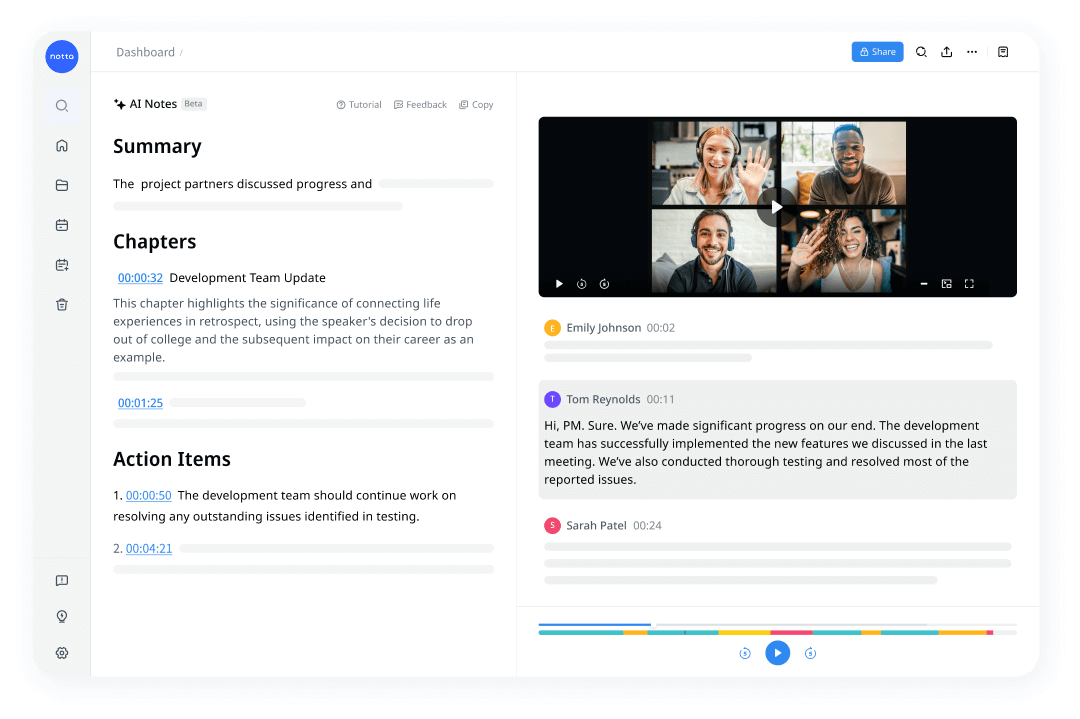
Transcription Machine: What is it and How it Works
98% accurate, real-time transcription in just a few clicks. 58 languages and multiple platforms supported.
A transcription machine is almost non-negotiable for busy professionals and transcribers these days. With the right equipment, you can manually create transcriptions of phone calls, interviews, podcasts, or YouTube videos. There are mainly two types of transcription equipment available — traditional and digital.
While they can be heavy on the pocket and even time-consuming, there are also AI transcription tools available online that provide automatic transcriptions for both audio and video files. When I first saw the automatic transcription tools in action, I was pretty impressed with their performance. Now, they’re the go-to tool for those looking to turn speech into text.
Here, I'll walk you through what a transcription machine is, how it works, and its two main types.
What is a transcription machine?
A transcription machine is a simple device that's responsible for manually converting spoken words into text. It perfectly combines the capabilities of professional human transcriptionists and dictation machines to streamline the transcription process.
This type of device typically consists of three things — a foot pedal, a control unit, and a headset. There are some advanced digital dictation machines that allow you to control playback speed, jump rates, rewind and fast-forward recordings and even resume or pause transcription.
How does a transcribing machine work?
The transcription machine works by analyzing the audio recording and then converting the spoken words into text. The transcriber uses the foot pedal of the transcription machine to control the playback of audio recording, while the headset is designed to listen to the audio clearly. The control unit helps with volume adjustment, playback options, and speed control — so you can accurately type what's being said.

Use Notta's AI transcription tool to quickly and easily transcribe audio and videos. We guarantee accuracy and ease of use.
Types of transcription equipment available
There are two different types of transcription equipment you can choose from: traditional and digital. Both types of equipment perform the same function — they help in converting audio into text.
Here's how each of these transcription or dictation machines differ in terms of features, working style, and intended uses.
Traditional transcription equipment
While many businesses and even professionals record notes with the help of a digital recording system, there are some companies that record via cassette tapes. The traditional transcribing equipment combines a microcassette transcriber, foot pedal, headset, computer, and a mechanical keyboard.
To use this: just pop the tape in the microcassette transcriber, use the foot pedal to start and stop recording, and then type the words.
Digital transcription equipment
Unlike the traditional method, digital transcription equipment speeds up the audio or video transcription process. For this, you'll need dual monitors, high-speed Internet, and transcription software. These digital transcription machines are preferred when working with digital files — and typically consist of software and a foot pedal for transcription.

Is there a more efficient transcription tool?
There's no doubt that traditional or digital transcription equipment can do their jobs — but these methods are quite time-consuming. Notta is a great alternative to these traditional methods. It's an automatic AI transcription tool and covers all the basic transcription requirements.

For example, it is accurate enough (98.86%), provides a short AI summary, and even helps you to share the transcripts with team members or clients. Beyond this feature, there's a Notta bot that automatically joins Zoom, Microsoft Teams, Google Meet, or Webex meetings and then creates an accurate transcript.
Key takeaways
Transcription machines are pretty good at converting audio to text, but they are far from perfect. You'll need to spend a lot of time listening to and then typing the words. Thankfully, there is a better solution! Notta is a useful AI transcription app that can save you a lot of typing.
The AI transcription tool has a free plan, which includes free transcription minutes per month. Unlike traditional or digital transcription equipment, this audio-to-text converter can automate the process of converting audio or video files into text — which can then be shared with anyone with a few clicks!
FAQs
What equipment do I need to be a transcriptionist?
If you want to start working as a transcriptionist, you'll probably need a comfortable headset, a computer/laptop, and word-processing software. As you grow in your career, keep expanding the equipment list by adding an ergonomically designed chair, dictionary, text expander, time-tracking software, industry-specific manuals, and, most importantly, file-converting software.
What are the basic rules of transcribing audio?
While transcribing the audio or video file, you'll need to carefully understand the basic rules and guidelines. Here are some of them:
You should type the words that are spoken in the given audio and in proper US English. You'll also need to focus on capitalization, spelling, and punctuation to avoid grammatical errors.
It might be tempting to correct the mistakes of the speaker — but as a transcriber, you shouldn't do this! Always write the words that are ‘actually’ spoken in the audio.
If you can eliminate some additional information, go for it! While transcribing files, you can omit page numbers, your comments, titles, and job numbers from the transcript.
How long does it take to transcribe 25 minutes of audio?
The time required to transcribe a 25-minute audio file will directly depend on the complexity of the content, the typing speed of the transcriptionists, and the type of equipment. Some professional and qualified transcriptionists take an hour to transcribe 25-30 minutes of audio. On the other hand, beginners might need two hours to manually transcribe the same file.